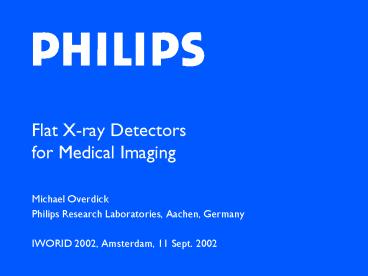Flat X-ray Detectors for Medical Imaging - PowerPoint PPT Presentation
Title:
Flat X-ray Detectors for Medical Imaging
Description:
Flat X-ray Detectors. for Medical ... IWORID 2002, Amsterdam, 11 Sept. 2002. PFL-Aachen, M. Overdick, 11 ... handling (no cassettes or films) Large ... – PowerPoint PPT presentation
Number of Views:894
Avg rating:3.0/5.0
Title: Flat X-ray Detectors for Medical Imaging
1
Flat X-ray Detectors for Medical Imaging
- Michael Overdick
- Philips Research Laboratories, Aachen, Germany
- IWORID 2002, Amsterdam, 11 Sept. 2002
2
Outline
- Flat Detector Technology
- Overview
- Key Components
- FD Performance
- Imaging Examples
- History Future
3
Flat Detector Technology
Scintillator
ADC
Addressing
Readout
4
Static detector Digital Diagnost
5
Dynamic detector Integris Allura
6
Scintillator CsITl needle crystals
- Thickness 550µm
- good X-ray absorption
- Needles act as light-guides
- sharp MTF
- CsITl emits green light
7
Photodiode array a-Si technology
- Same technology as used in active matrix LCDs
(TFT displays) - a-Si photodiodes low dark currents,high
sensitivityfor green light
8
Low noise readout electronics
- Driver and readout chips on flex modules
- Allowing very compact designs
20 cm
9
Main noise sources in Flat X-ray Detectors
TFT switch
Gate line
Photo- diode
Common electrode
Column read-out line
Pixel circuit of dynamic FD
CSA
10
Integris AlluraFlat Dynamic Detectorfor Cardio
11
Technical Data
12
Detective Quantum Efficiency (DQE) for a Flat
Dynamic Detector
From F. Busse et al., Proc. SPIE 4320 (2001)
287-298
13
DQE for a Static Flat Detector
Source PMS Hamburg
14
Static FD performance vs. Screen/Film systems
- High DQE
- Fully digital
- Simple handling (no cassettes or films)
- Large dynamic range
15
X-ray film Dynamic range
8 mAs
0.5 mAs
2 mAs
4 mAs
16 mAs
32 mAs
63 mAs
Over-exposed
Under-exposed
16
Flat detector Dynamic range
typical usage
17
Dynamic FD performancevs. Image intensifiers
(II-TV systems)
- Larger dynamic range
- Size weight
- Undistorted images
- Immune to magnetic fields
- Strongly reducedVeiling glare and fixed pattern
noise
18
Imaging examplesDynamic FD Heart arteries with
contrast agent
19
Imaging examplesStatic FD Shoulder and finger
1 cm
20
History
- 1989 Start of FD Research Project at Philips
- 1993 8x8 FD Prototype
- 1997 Joint venture with Thomson and Siemens
(Trixell) - 2000 Introduction of static FDs by Trixell and
GE Medical - 2001 Introduction of dynamic FDs for Cardio
application (GE Medical and Trixell)
Apart from CsITl based FDs also Selenium based
FDs are availble (e.g. from Anrad/Toshiba),
mainly used for static applications (e.g.
mammography).
21
Future
- Flat Detectors for further applications and with
different sizes will enter the market. - FDs will gradually replace II-TV systems.
22
And what about CMOS Pixels?
- CMOS Pixel Electronics
- Amplifier in each pixel
- Additional functionality
- But
- Cost and feasibility of large area CMOS coverage!
- Please carefully check against FD performance
(as the new gold standard)
- Counting vs. Integrating
- Nice topic for an extra talk!
- Observe the high maximal count rates (? 109
counts/s mm²)
23
Conclusions
- Flat Detectors are out now in the market(mainly
static detectors and cardio detectors) - FD technology offers various benefits as
compared to conventional systems. - Scintillator, a-Si technology and low noise
electronics are the key FD ingredients. - New X-ray detector developments should use FD
performance as their new benchmark.
24
Acknowledgements
- Philips Medical Systems (Best, Hamburg and North
America) - Trixell (Moirans, France)
- Colleagues at Philips Research Aachen and Redhill
25
(No Transcript)
26
Residual signalsDependence on the Refresh Light
Duration
Normalized residual signal _at_ 30µGy
Normalized residual signal _at_ 21x30µGy
g
RLD0µs
-0.74
g
g
RLD0µs
-0.92
RLD10µs
-0.77
g
g
RLD10µs
-1.06
RLD50µs
-0.83
g
g
RLD50µs
-1.24
RLD250µs
-0.89
Time in s after exposure
Time in s after last exposure
? Stronger refresh light accelerates decay of
Res. Signals
(M. Overdick et al., Proc. SPIE 4320 (2001) 47-58)































